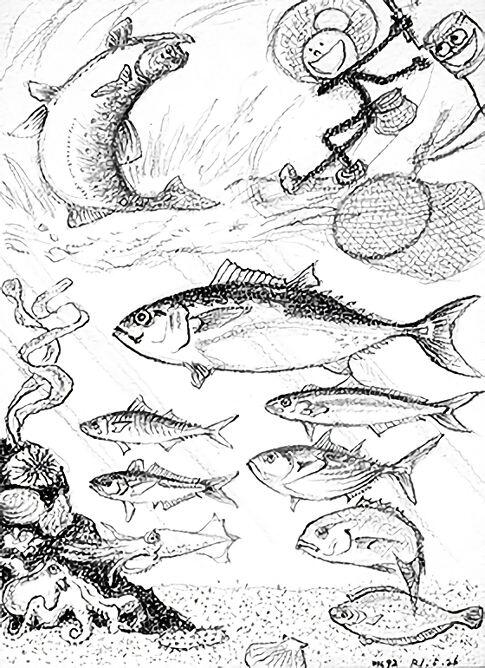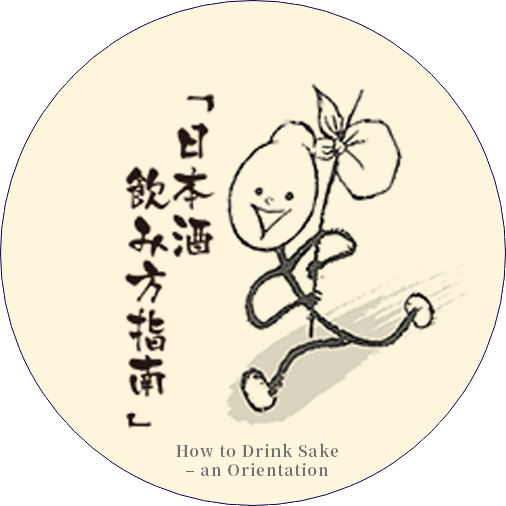| Yeast |
“This time we’ll talk about pairings with fish, something sake is very good at!” |
| Kimoto |
“Yup. Do you know why sake fits so well to fish?” |
| Yeast |
“Because Japan is an island, Japanese food mainly consisted of fish in the past.” |
| Kimoto |
“Right. To be more precise, sake envelops and eliminates the fishy smell. White wine, on the contrary, can emphasize the fishy smell. And the umami of sake harmonizes well with dashi (soup stock) made with fish.” |
| Yeast |
“I see! That’s the great strength of sake. Can you now tell me which sake fits to which fish dishes?” |
| Kimoto |
“Alright. There are various types of sea food, such as the white meat of flounder and sea bream, the red meat of tuna and skipjack, or the meat of fish with a silvery skin as horse mackerel and mackerel. And then we have sea creatures as squid and octopus, sea cucumber and sea urchin, shellfish as scallops and oysters, and also abalone, and further fish eggs as salmon roe and caviar. Let’s see which sakes fit to all these types of sea food.” |
| Yeast |
“Ahem. Last time I learned that light sake fits to light dishes and rich sake to heavier dishes. We made pairings of two of a kind.” |
| Kimoto |
“Yes. As an example of a light taste, we have octopus with lemon and salt. Light and smooth namazake (unpasteurized sake) would make a good pairing.” |
| Yeast |
“I’d like to pair Karakuchi Kimoto or Gokujo Kimoto with plain white fish meat with a gentle umami such as salt-grilled sweetfish with some drops of sudachi citrus fruit.” |
| Kimoto |
“Very good! Yeast, do you know the difference between fish with red meat and with white meat? Fish with red meat is a migratory fish which is always in movement, and therefore it has a lot of hemoglobin in its blood which gives the red color. In contrast, fish with white meat lives near the bottom of the sea and doesn’t move around so much, but it needs the agility to suddenly catch a prey and therefore its meat is taut.” |
| Yeast |
“I see. How do they differ in taste?” |
| Kimoto |
“Fish with red meat like tuna and yellowtail has a lot of fat and therefore has a rich taste. The muscles which are always in action contain lactic acid. This again makes a good pairing with kimoto sake which uses lactic acid fermentation. I therefore suggest as best pairing Junmai Kimoto.” |
|
 |
| Yeast |
“And what about fish with white meat as flounder and sea bream?” |
| Kimoto |
“Fish with white meat lacks a bloody color and is low in fat and high in proteins. It has a light umami and al dente-like chewiness. In case of sashimi, Kaiden (Masakura) would be a good pairing.” |
| Yeast |
“What about fish with a silvery skin, as Pacific saury and sardines?” |
| Kimoto |
“Such fish is also called fish with blue-red meat. It seems to have the effect of reducing bad cholesterol and cleansing the blood. A matured sake like Junmai Kimoto Classic would pair well with fatty Pacific saury.” |
| Yeast |
“I see. What about appetizers like sea urchin and monkfish liver, which you are so fond of?” |
| Kimoto |
“Elegant Minowamon is excellent with these rich and round tasting appetizers. Just thinking about it makes me thirsty!” |
| Yeast |
“We continue! What sake fits to oysters, scallops and abalone?” |
| Kimoto |
“Fresh namagenshu would fit with raw oysters with lemon. In case of creamy clam chowder, Junmai Kimoto would be best. Kaiden (Masakura) and Minowamon pair well with the soft sweetness of scallops. And full-bodied Rakutenmei goes well with the rich umami of abalone steak.” |
| Yeast |
“Finally, Kimoto, what is your most lavish pairing?” |
| Kimoto |
“Myoka Rangyoku in a somewhat large glass with high-grade spiny lobster!” |
| Yeast |
“Wow! That’s the very best!” |





